The Last Hurrah? |
Read more at in70mm.com The 70mm Newsletter |
| Written and photographed by: Jonathan Kleefield, M.D., Boston, USA | Date: 17.06.2024 |
 In
an interview recorded for a DVD version of
"Lawrence of Arabia," Steven Spielberg claimed it was that
particular movie which stimulated him to pursue his now-legendary
directorial career. While the outcome of my first viewing of this film in
1963 did not have a result of similar magnitude, I feel that experience was
one of the highlights of my cinematic life. I have indicated such an
impression in previous articles I have penned for this journal. In
an interview recorded for a DVD version of
"Lawrence of Arabia," Steven Spielberg claimed it was that
particular movie which stimulated him to pursue his now-legendary
directorial career. While the outcome of my first viewing of this film in
1963 did not have a result of similar magnitude, I feel that experience was
one of the highlights of my cinematic life. I have indicated such an
impression in previous articles I have penned for this journal.• Go to Eighteen Years Later • Go to A Nostalgic View of 70mm in New York City - 1950-1970 • Go to Showcase Presentations in Boston Because of my affection for this film, I have seen it multiple times in theaters, including the 1989 photochemical restoration discussed below. I have owned nearly every video format of it as the technology evolved, now having a 4K Blu Ray disc to watch in my small home theater, also described in a previous article for this journal. Both the 2012 Blu Ray disc and the present 4K version were created after a meticulous video restoration supervised by Grover Crisp, a high-ranking official at Sony Pictures, which had bought the original production company, Columbia Pictures. Consequently, the quality of the video images is pretty much the current standard for comparison. Nevertheless, we owe a debt to Robert Harris, who intervened just in time in the late 80’s to perform an exacting, exhaustive photochemical restoration, which literally saved the film’s life, as it was close to being irretrievably deteriorated (for that time, when digital repair techniques were not yet available). It turns out that this motion picture was to be shown at the Somerville Theatre using the two Norelco DP70 projectors Mr. Harris had owned during his herculean effort to save the film. So seeing it that way was surely a special experience! |
More in 70mm reading: Eighteen Years Later A Nostalgic View of 70mm in New York in70mm.com News Peripheral Vision, Scopes, Dimensions and Panoramas in70mm.com's Library Presented on the big screen in 7OMM 7OMM and Cinema Across the World Now showing in 70mm in a theatre near you! 70mm Retro - Festivals and Screenings |
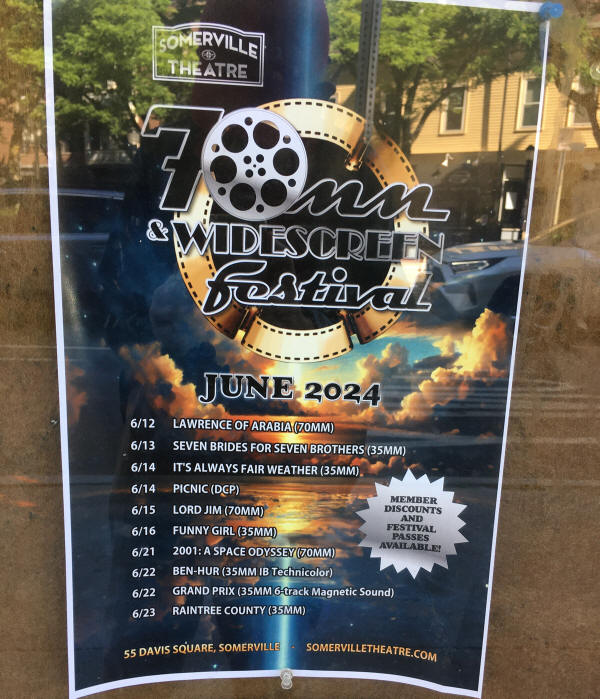 At
this journal editor’s prompting, I made a trip a few days ago to the
Somerville Theater, an approximately 700 seat facility which has had
extensive restoration and systems updating. It is located in Davis Square,
which actually is triangular in shape. The building housing the theater
dates from 1914. A superb history of the Somerville is available on their
website,
so I will not repeat the extensive information available within it. The
theater is about six miles from the center of Boston, and immediately
contiguous to convenient public transportation. At
this journal editor’s prompting, I made a trip a few days ago to the
Somerville Theater, an approximately 700 seat facility which has had
extensive restoration and systems updating. It is located in Davis Square,
which actually is triangular in shape. The building housing the theater
dates from 1914. A superb history of the Somerville is available on their
website,
so I will not repeat the extensive information available within it. The
theater is about six miles from the center of Boston, and immediately
contiguous to convenient public transportation. The occasion of my visit to see “Lawrence” was part of their annual 70mm Film Festival. Before the movie was shown, the Lead Projectionist, David Kornfeld, appeared on stage, and briefly recounted the film’s history, including its somewhat inaccurate portrayal of events at the time, as well as casting the over six foot tall Peter O’Toole as Lawrence, who in fact was quite short in stature. It should be noted that under Mr. Kornfeld’s direction, each DP70’s motor was modified so that they are now capable of continuously variable speed selection, thus allowing the proper 16fps for silent films, the standard 24fps sound speed, and up to 30fps for the only two Todd-AO films that used this higher frame rate to reduce image flicker ("Oklahoma!" and "Around the World in 80 Days"). In a brochure regarding the Festival, it was indicated that Mr. Kornfeld has updated the audio reproduction facilities on the Norelcos to accommodate any digital sound system format, as well as reproduce four or six channel magnetic sound. “State of the art” amplification and speaker systems are used in this facility- the results, as noted below literally “spoke for themselves.” |
|
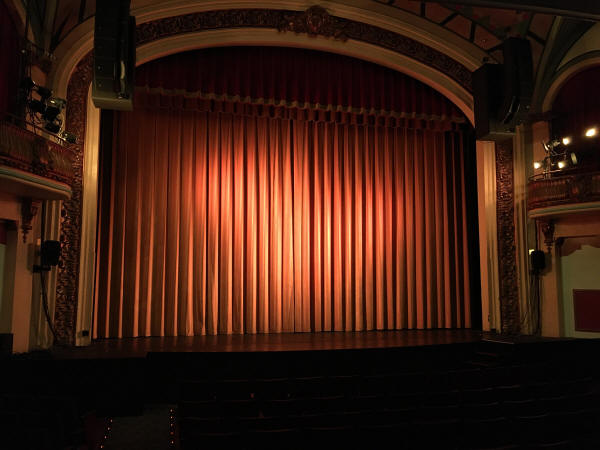 Presentation-wise,
this team at the Somerville gives films the respect they deserve. A lovely
curtain covered the screen during the film’s Overture, and at the precise
moment the Columbia Pictures logo appears, the curtain majestically parted.
Before the show, Mr. Kornfeld did inform the audience that the print being
shown was made for the 1989 restoration, so the inevitable specks of dirt
were now present on this 35 year old specimen, particularly near the
beginning and end of each reel- the areas most vulnerable to contracting
such blemishes. Scratches, however, were quite minimal in extent. Many
splices were present, but thankfully none caused any interruption in
projection. By the way, this movie was shown as they used to be exhibited-
one reel at a time, with perfect changeovers between the two projectors
accomplished on every occasion. Sadly, the film displayed some color
alteration, with the darker scenes having a greenish hue, and as seems
typical for film projection these days, a lack of truly deep blacks to
maximize image contrast. Compared to the 4K Blu Ray version I own, the color
saturation and apparent sharpness of the film image were also mildly
decreased. But, seeing it on “the big screen” remains a very special
experience. Moreover, I have not encountered such clear, truly high fidelity
sound presented at the optimum intensity in a long time- dialog
intelligibility was superb. The musical reproduction was also exceptional-
kudos to Mr. Kornfeld for his design and scrupulous maintenance of his sound
equipment! Presentation-wise,
this team at the Somerville gives films the respect they deserve. A lovely
curtain covered the screen during the film’s Overture, and at the precise
moment the Columbia Pictures logo appears, the curtain majestically parted.
Before the show, Mr. Kornfeld did inform the audience that the print being
shown was made for the 1989 restoration, so the inevitable specks of dirt
were now present on this 35 year old specimen, particularly near the
beginning and end of each reel- the areas most vulnerable to contracting
such blemishes. Scratches, however, were quite minimal in extent. Many
splices were present, but thankfully none caused any interruption in
projection. By the way, this movie was shown as they used to be exhibited-
one reel at a time, with perfect changeovers between the two projectors
accomplished on every occasion. Sadly, the film displayed some color
alteration, with the darker scenes having a greenish hue, and as seems
typical for film projection these days, a lack of truly deep blacks to
maximize image contrast. Compared to the 4K Blu Ray version I own, the color
saturation and apparent sharpness of the film image were also mildly
decreased. But, seeing it on “the big screen” remains a very special
experience. Moreover, I have not encountered such clear, truly high fidelity
sound presented at the optimum intensity in a long time- dialog
intelligibility was superb. The musical reproduction was also exceptional-
kudos to Mr. Kornfeld for his design and scrupulous maintenance of his sound
equipment! |
|
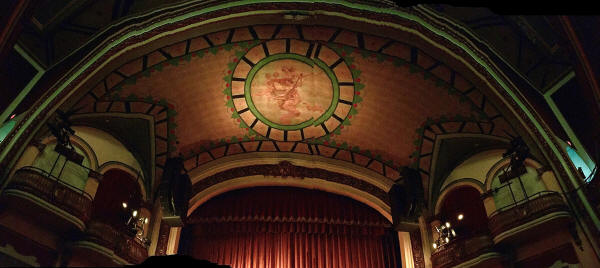 The
audience attending numbered about 300. I was delighted to see a wide range
of ages of the patrons, with several “30-somethings” behind me talking
excitedly before the film began about production details- I was thus
thrilled to see that there is a new generation of cinephiles! And, unlike
most movie theater experiences these days, during the presentation there
were no cell phones ringing, nor people talking with one another- rather,
rapt attention to the show! The
audience attending numbered about 300. I was delighted to see a wide range
of ages of the patrons, with several “30-somethings” behind me talking
excitedly before the film began about production details- I was thus
thrilled to see that there is a new generation of cinephiles! And, unlike
most movie theater experiences these days, during the presentation there
were no cell phones ringing, nor people talking with one another- rather,
rapt attention to the show! All in all, the trek was more than worthwhile, and gave me a burst of that nostalgic feeling I wrote about in this journal in 2005, when being able to see a film the way it was meant to be experienced. But, as I now approach my ninth decade, I realize there is no medical equivalent of Robert Harris to perform a “restoration” on me- thus, the title of my article. So, at least in the emerging twilight of my life, and thanks to the Somerville Theatre, I could once again relive the joys of properly viewing an epic film. I wish the staff continued success in their effort to remind people of our important 70mm cinema heritage, particularly given the increasing difficulty in sourcing such prints. The audience responded most enthusiastically, and for good reason! |
|
More Pictures of the Somerville in Boston |
|
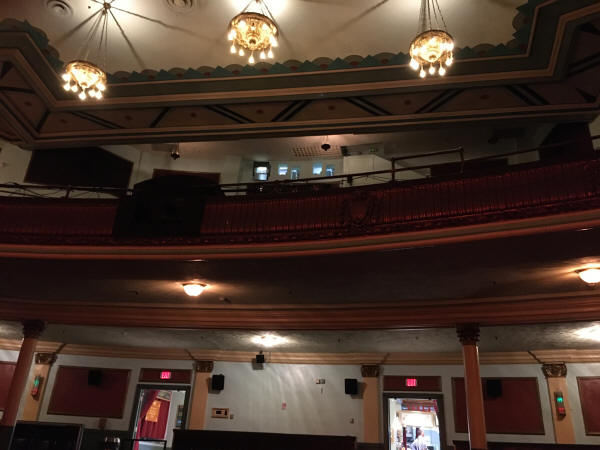 Projection
booth, despite
the high location, no observable image keystoning, and no “rectified” print used,
either. Amazing! Projection
booth, despite
the high location, no observable image keystoning, and no “rectified” print used,
either. Amazing! |
|
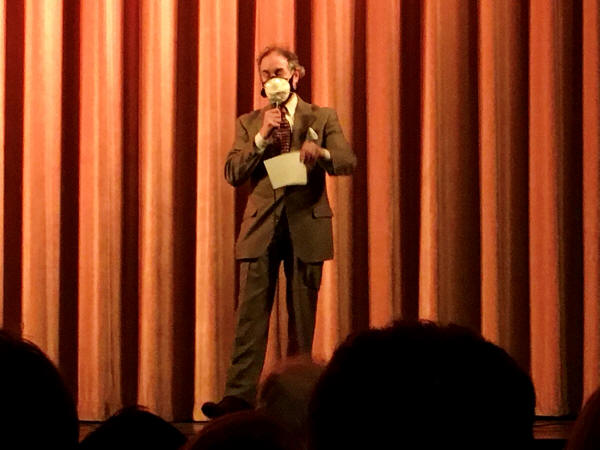 Before
the show, Mr. Kornfeld informing the audience that the print being shown was
made for the 1989 restoration Before
the show, Mr. Kornfeld informing the audience that the print being shown was
made for the 1989 restoration |
|
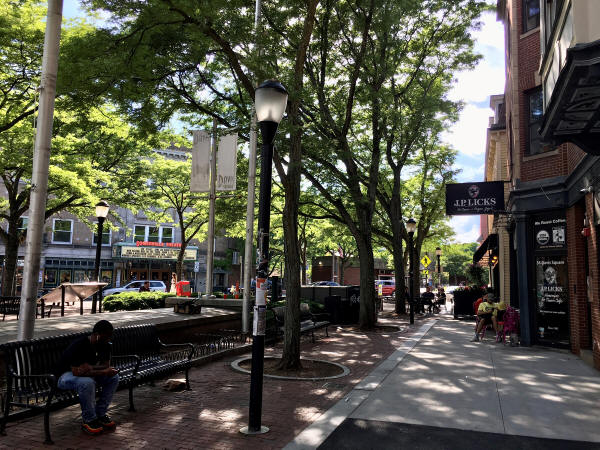 The
Somerville Theater is located in Davis Square The
Somerville Theater is located in Davis Square |
|
 • Go to The Last Hurrah? |
|
| Go: back - top -
news -
back
issues Updated 22-01-25 |
